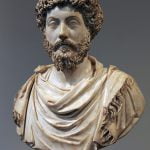Aquincum was in the current place – Óbuda (translated from Hungarian – Stara Buda), which is the oldest district of Budapest. As a settlement, it was built on the site where 100 years BCE the Roman legion established a transitional military camp. At the end of the first century BCE, it was transformed into a permanent camp on the Danube, guarding the borders of the Roman Empire. Six thousand soldiers were stationed in the camp. The camp soon turned into a military settlement called Aquincum.
Aquincum – Illyrian-Celtic Akink, meaning “rich waters”, “wealth of waters” – was a huge city of 12-40 thousand people under the law of a municipality, granted by Emperor Hadrian. It was located in the Roman province of Pannonia, in a large area of today’s Budapest, Hungary. It was the most northeastern Roman settlement. Founded by the Celts, it then served for some time as a military base for Roman legions. Around the 2nd century CE, it was a bustling city with baths, thermal baths, palaces, amphitheatres and an aqueduct. The origins of the construction of the ancient city date back to 19 CE. The city had a network of hard-surfaced streets, central heating devices powered by water from hot springs, and many sacred and communal buildings. Roman monuments are also found elsewhere in Budapest, on the other side of the Danube, on the north side of the Elizabeth Bridge span – Contra – Aquincum (Transaquincum). Emperor Commodus ordered the construction of a line of defence and observation towers along the Danube, guarding the north-eastern borders of the empire against the invasions of the Germans and Sarmatians. Fortifications stood on both banks of the river. In Aquincum, in 375 CE Emperor Valentinian II was proclaimed emperor.
However, as early as 410 CE the city was handed over without a fight to the Huns, who plundered and destroyed it.
The famous buildings in Aquincum are:
- military amphitheatre (at the intersection of Pacsirtamezö and Nagysombat streets), from the middle of the 2nd century CE, one of the largest (131.8 m x 108.4 m; 10-12 thousand seats) military theatres in the then Roman Empire.
- civil amphitheatre, smaller, 86.5 x 75.5 m; 6-7 thousand places.
- Thermae Maiores – thermal baths, Roman baths with mosaics; dimensions 120 m x 140 m.
- cella trihora – foundations of the cemetery chapel from 360 CE, one of the oldest monuments of Christian architecture in Hungary.








